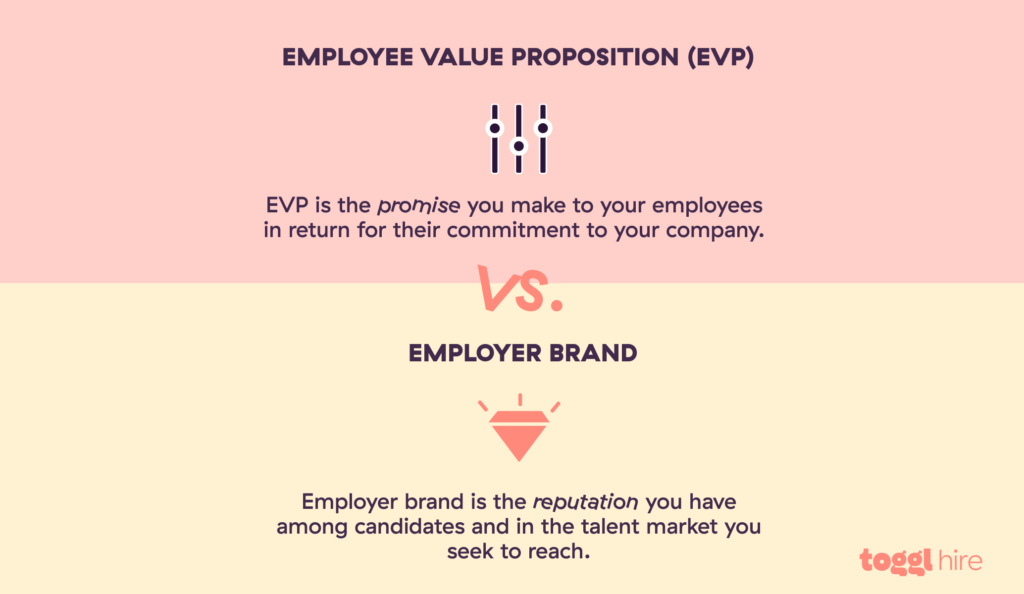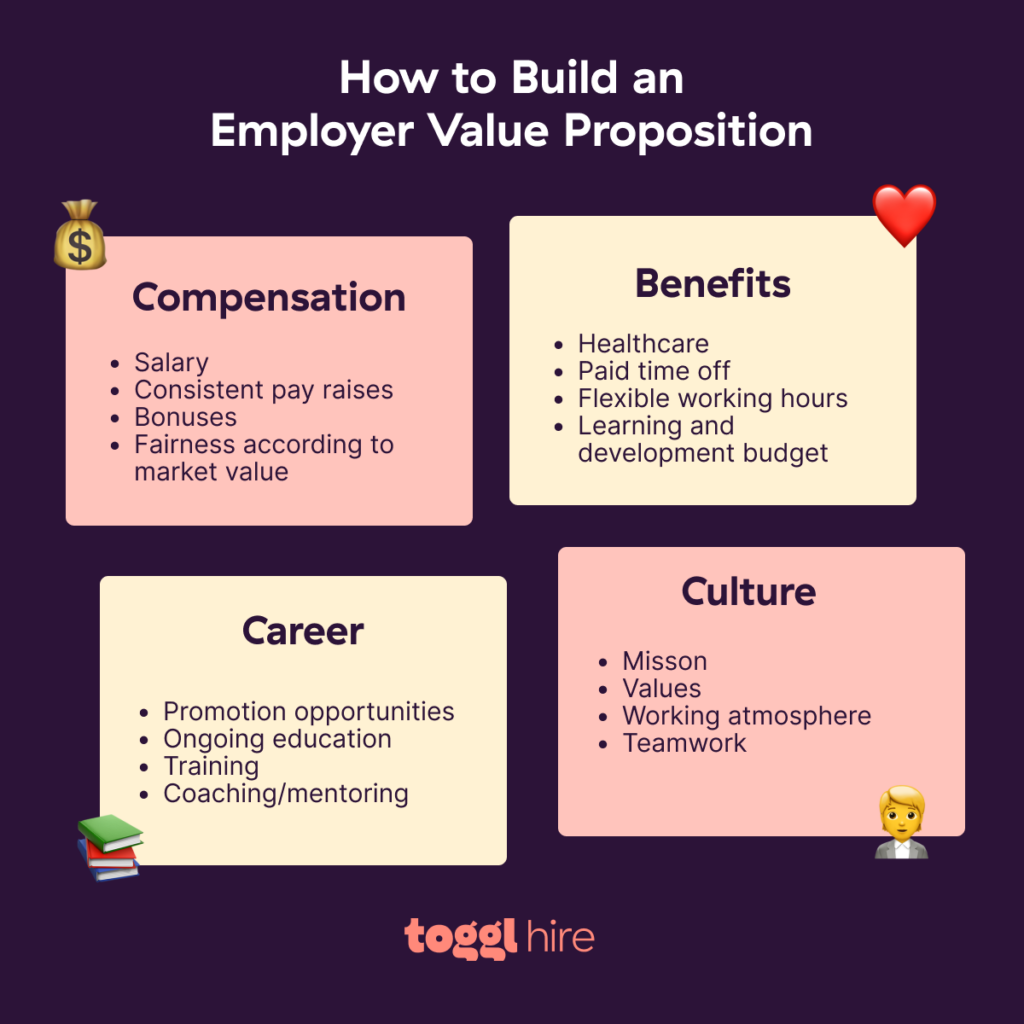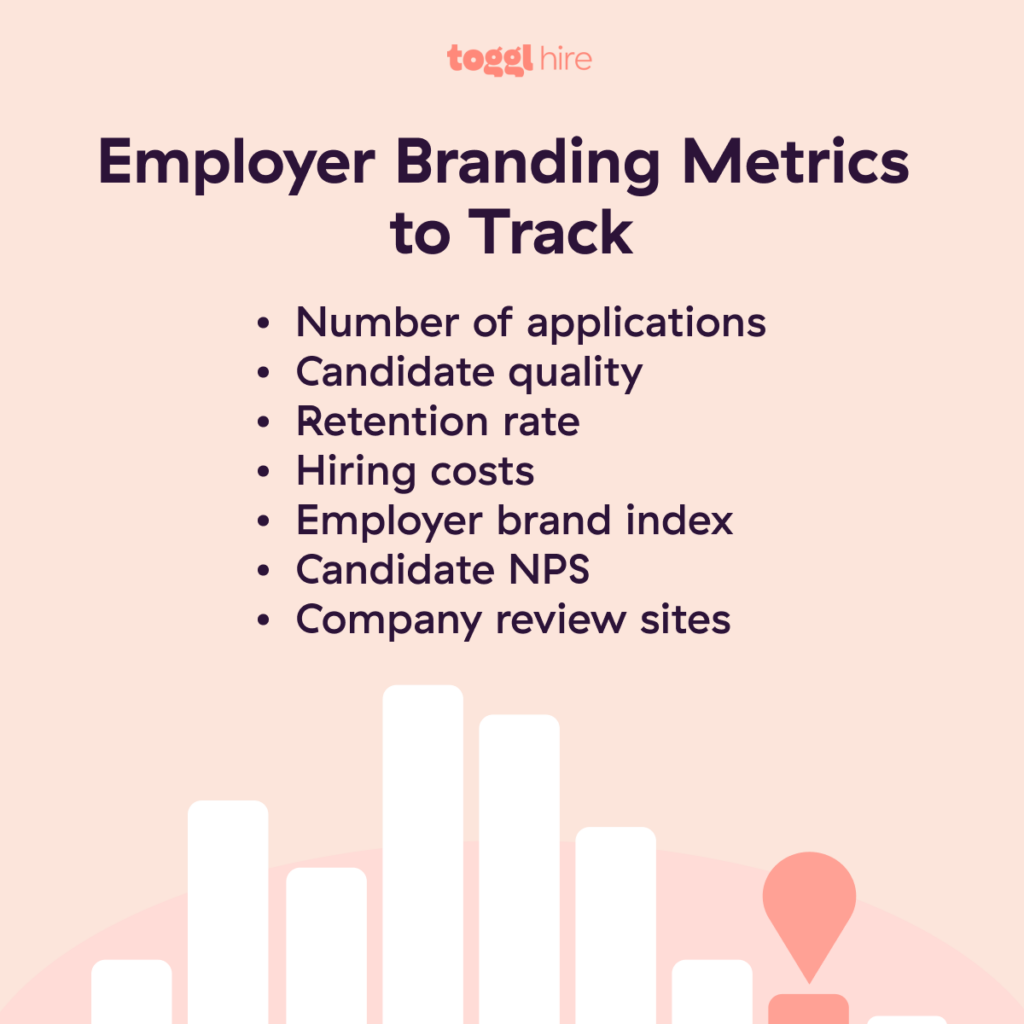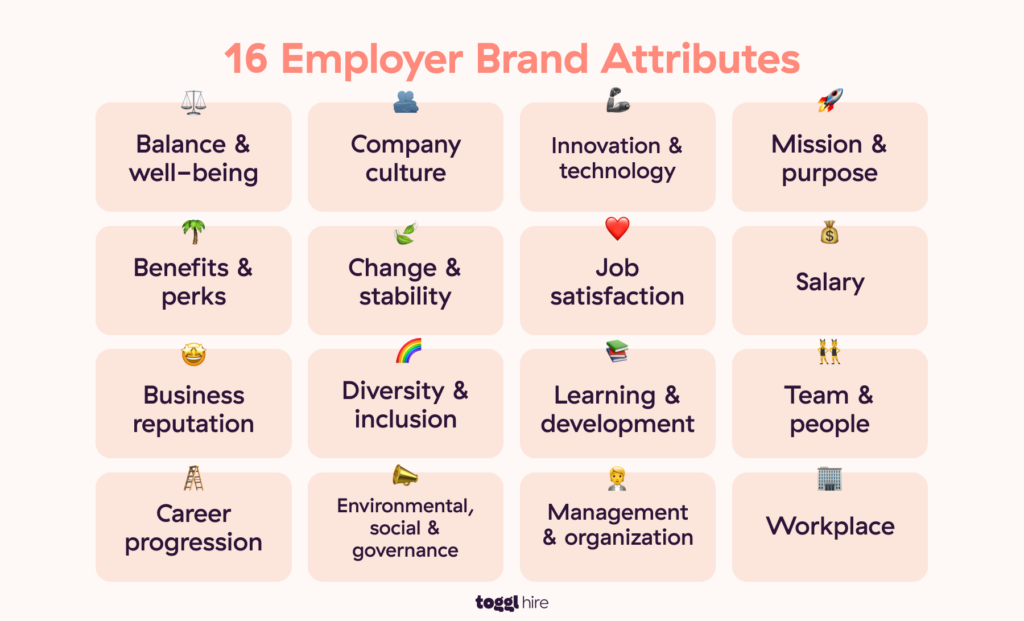Employer branding isn’t just a buzzword—it’s a critical element of your company’s identity.
However, we often see recruitment professionals and hiring teams struggling with employer branding. It’s equal parts art and science…the art of making your company the place everyone dreams of working while also effectively marketing your real workplace culture and values.
It’s, unfortunately, not something you can skimp on, either. To get top talent in today’s job market (and retain them in your company), you need to be a standout employer. So, today, we’ll explain what employer branding is and how to manage it, as well as provide some great employer branding examples.
TL;DR — Key Takeaways
Employer branding is a strategy for managing how your company is perceived as an employer. It consists of your reputation, employee value proposition, and employee experience.
Great employer branding has many benefits, such as helping you stand out as an employer, attracting better candidates, lowering the cost and time to hire, and getting better referrals.
There are many ways to build a great employer branding strategy. It all starts with an employer brand audit, developing a strong employer value proposition, and gathering insights from existing employees.
Once put into action, your employer branding strategy is an important tool for improving the candidate experience and retaining your best talent.
Key employer branding metrics to track include the number and quality of applicants, employee retention rate, hiring costs, employer brand index, candidate NPS, and company reviews.
What is employer branding?
Employer branding is an HR strategy for managing your company’s perceived reputation as an employer in the job market. In simple terms, employer branding is how your current and former employees perceive you and talk about you in and outside of the workplace.
According to the Harvard Business Review, employer branding has three main components:
Reputation
Your organization’s reputation means a lot to potential employees when deciding whether to work for you. Ultimately, it becomes their reputation too. According to the Harvard Business Review, reputation encompasses the three Cs:
Career catalyst
Culture
Citizenship
The first entails how likely new employees are to grow in their roles and what their career progression will look like during and after your company. The second is the company story and work environment you create.
Last but not least, citizenship is how your company makes a difference in the world. The better the citizenship story, the more engaged the workforce is.
Employee value proposition
This is the definition of the relationship between the employer and the employee. It describes your expectations and what the employees get in return for fulfilling them.
For example, compensation, employee benefits, development opportunities, work-life balance, or anything else that makes you a valuable employer.

Make sure you deliver on your EVP’s promises, or you could seriously damage your employer brand. Need some inspiration to start? View our helpful guide to 11 Strong Employee Value Proposition Examples.
Employee experience
The entire employee journey spans everything from employee interviews, offers, and onboarding to day-to-day operations. As HRB states, when your employees understand your expectations and meet them successfully, your employee experience is bound to be good.
Both candidate and employee experiences are vital components of your employer brand:
- Candidate experience deals with the impression of your company throughout the recruitment stages. Factors that impact it include communication, feedback, and ease of application.
- The employee experience starts with your first days and ends with offboarding. Key factors that can boost the employee experience include having an employee development plan, company culture, and flexible working policies.
Why is employer branding important (for you and job seekers)?
Employer branding can help attract job seekers and retain your current employees, but there’s more to it than meets the eye (like nearly every other important metric or hiring initiative, it’s very multifaceted). These are some of the practical benefits of a healthy employer brand.
Standing out in a competitive job market: If you can’t compete in terms of salary or having an engaging company store, building a brand can help you get noticed by potential employees.
Attracting better applicants: If your company’s culture and employer brand are bad, 75% of employees today are likely to turn down a job from you.
Lower cost per hire: With higher employee engagement and better branding, your company’s reputation will help you lower the cost of finding great job candidates.
Reducing time to hire: A strong employment brand can reduce your time to hire (that can be anywhere from days to four months), improving your recruitment process and saving even more money.
Employee referrals are easier: If you have high levels of employee satisfaction, you’re more likely to get referrals from those internal employees. Referred employees stay longer in your company, are more likely to be satisfied in their jobs, and cost less to hire them. So…it’s basically a win-win-win all around.
How to build an employer branding strategy
Companies that actively manage their employer branding attract candidates who are 94% more likely to apply for a job. To reap the benefits outlined above, you may need to build or revamp your employer branding strategy. Here’s how to get started, step by step.
1. Conduct an employer brand audit
An employer brand audit is a self-assessment of the current state of affairs. While it’s mostly based on subjective opinions, you can standardize the process using some of the following methods:
Employee surveys: See what the employees think of their career growth prospects, employee value proposition, company culture, and overall experience with you as their employer
Social media feedback: Use your profiles (e.g., LinkedIn company page) to ask former and current employees, followers, and fans what they think about your employer brand, such as your employer branding content, reports of company events, etc.
Website feedback: Ask visitors on your careers page how they feel about the state of your employer branding. You can incorporate surveys or forms for open-ended feedback.
2. Develop a strong employer value proposition
An employer value proposition is what you expect from your employees and what they can expect from you in return. This document contains your mission, vision, values, and company’s unique attributes.
It’s what makes you unique as an employer and interesting to potential employees. It’s not only a practice in employer branding, it’s a tool that will make your recruitment efforts much easier.
The most important tip we can give is to be authentic. Write it from scratch and from the heart. In an age when everyone uses ChatGPT, just being human can make all the difference. If you’re unsure where to start, ensure your EVP covers everything suggested below. 👇

3. Get input about company culture from existing employees
Company-created materials are great, but it’s even better to get the word from people who actually work in your company. Think of the following formats:
Employee interviews (audio and video)
Testimonials and quotes
A day-in-the-life-of types of posts and employee stories
Meet the team, e.g. introducing the marketing team
You’d be surprised at how much easier it is to improve your existing employer brand or create a new one if you just involve your employees. Plus, much of this content can be reused across your careers page, social media platforms, and other places.
4. Create a strong communication plan
What good is all of that great content if it stays buried in your Asana board?
Come up with a plan to share each of the content pieces you created with your team across different platforms. Whatever messaging you choose, make sure it’s consistent throughout all your published content across every touchpoint (very similar to the way you’d market your “real” brand).
Some places to promote your content and attract top talent include:
Your career site
Social media channels
Your blog
Industry events and job fairs
Guest events like podcasts, interviews, and others
5. Improve the candidate experience
58% of candidates have declined a job offer because of a poor candidate experience. And, honestly, we’d be willing to bet that number is even higher, as companies have grown notorious for treating candidates horribly in the past few years simply because the market has favored employers.
The candidate experience is everything an applicant experiences from the moment they hit “apply” until they receive an offer from you.
Creating an amazing candidate experience is a lengthy process, but here are some great starting points:
- Make it easy to apply and don’t require applicants to jump through hoops and write lengthy cover letters
- Communicate clearly about what the hiring process looks like and what they can expect
- Give feedback quickly and honestly
- Create an inclusive environment and eliminate unconscious bias from the hiring process
6. Work to retain your top talent
Retain your top employees to build a strong employer brand and ensure long-term success for your company. Standing out in front of job seekers becomes easier when you have long-term employees speaking well about you.
Some strategies for employee retention include:
Offer career advancement opportunities
Recognize your employees’ successes publicly and improve employee engagement
Offer competitive compensation and employee benefits
Take care of employee well-being through mental and physical health initiatives
Great employer branding examples
Ready to start building your employer brand? It’s not always easy, so let’s look at some great examples to inspire your efforts.
Cisco
This telecommunications company has been around for a while and has built up a reputation as an amazing place for employees. If you look at their company overview, you’ll see that 20% of their employees have been with them for 6-10 years.
In addition, 98% of Cisco employees state that it’s a great place to work, compared with just 57% in the average US company.
Adobe
When Adobe noticed that certain employees’ social media content brought in more revenue than their own company’s content, they didn’t fire their social media manager.
Instead, they gave their employees room to share their own thoughts and speak about the company. Among other things, this move resulted in Adobe winning an award for the best employer brand in 2022.
Bain and Company
Winning Glassdoor’s 2024 Best Place to Work ought to tell you a lot about how amazing Bain and Company, a consulting company with a global footprint, is at employer branding.
What makes them stand out is that they invest time and resources into their employees. This ensures high employee satisfaction and better employee retention.
Hilton
The hotel chain was named the best place to work in 2024, and this is just one of the many employer branding awards it has won in the past.
With over 7,500 properties, Hilton leadership learned to value different backgrounds and cultures and work with people as they are. As a result, 95% of employees at Hilton say that it’s a great place to work.
Employer branding metrics to track
The best way to determine if your employer branding efforts are working is to track relevant metrics over time. You can then compare your results to industry standards and see if you’re making improvements in company culture and branding efforts.

Number of applicants
The average number of applicants per job opening varies depending on the source, ranging from 29 to 250. Conclusive data is hard to find because it depends on many factors, including industry, seniority, platforms where the job was posted, etc.
Track the number of job seekers applying for your roles over time so you have a basis for comparison against your own results. However, don’t aim to get as many applicants as possible because your ultimate recruitment goal is quality.
Candidate quality
Simply put, this is the quality of the job seekers applying for your roles. It’s very difficult to quantify this, so let us define it as the number of applicants who meet your job requirements.
These are potential candidates who have the right experience, hard and soft skills, and educational background, share your company values, and would be a great cultural fit.
It’s better to have 30 candidates of great quality than 300 you wouldn’t invite to an interview.
Assess candidate quality from the start with skills testing. Filter out unsuitable candidates without any effort at all, and the cherry on top? 4 out of 5 candidates love the skills-first approach to hiring. Gamify your application process with quiz-like skills tests to boost your employer brand, provide instant feedback, and attract passive candidates.
Employee retention rate
This value tells you how long an employee stays in your company. The longer your current employees are with you, the higher the retention rate. If your business can retain talent, it builds a positive employer brand.
To understand retention, you need to take a look at employee turnover — how many people leave your company in a certain period of time. According to the US Bureau of Labor Statistics, the average turnover rate in 2024 is 3.5%.
Having a high turnover rate not only harms your employer brand but also impacts your total costs of hiring.
Hiring costs
This includes the total costs of hiring an employee: creating job ads, promoting them on job boards, LinkedIn, or through social media platforms, assessing candidates, running interviews, background checks, making an offer, etc.
The average cost to hire an employee in 2023 was just over $4,700. This number won’t affect your employee value proposition, but it gives you valuable information as an employer. Having a great employer branding strategy can help you get better-quality candidates with lower hiring costs.
Employer brand index
Link Humans developed this metric, which considers 16 different attributes to give a single Employer Brand Index (EBI) value.
The only problem? Besides being overly complex, you have to pay to get your EBI score assessed by Link Humans.

Candidate NPS
An NPS score is a survey score that tells you how likely a candidate is to recommend your job opening to someone else. At the end of the job application process, you can ask your applicants to take a short NPS survey and describe their experience.
The average NPS will depend on the stage of the hiring process the candidate is in. For example, the average NPS for candidate experience is 37.
Company review sites
One of the easiest ways for job seekers to assess your company’s reputation is to go online on independent websites such as Glassdoor. These platforms have employee testimonials and ratings that are often anonymous and speak volumes about your company culture.
Do more than just monitor your profiles to see what your former and current employees are saying about you, though. Actively participate and manage your profile to build a strong employer brand.
Boost your employer branding with Toggl Hire
Having a proper employer branding strategy in place is a worthwhile investment for your business’s future. You’ll retain your current employees more effectively and attract better potential candidates more easily and at lower costs.
At Toggl Hire, we can help you build a better employer brand with little effort. Use our skills tests and other candidate-focused features to make the hiring process smoother, provide a better candidate experience, and showcase your employer brand from the very start.
Candidates get instant feedback, while you get a large number of pre-vetted candidates and a better understanding of who the good applicants are in days, not months.
Sign up for a free Toggl Hire account and revamp your employer brand!
Mile is a B2B content marketer specializing in HR, martech and data analytics. Ask him about thoughts on reducing hiring bias, the role of AI in modern recruitment, or how to immediately spot red flags in a job ad.






